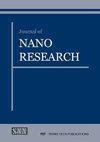Synthesis of Tungsten-Cerium Doped Titanium Oxide Nanocatalyst to Remediate Water by the Degradation of Atrazine Herbicide
IF 1
4区 材料科学
Q4 MATERIALS SCIENCE, MULTIDISCIPLINARY
引用次数: 0
Abstract
Tungsten (W) and Cerium (Ce) doped nanoTitanium oxide (TiO2) nanophotocatalyst were prepared by the sol-gel method and their photodegradation effect against atrazine herbicide were investigated. The doping of the nanocatalyst took place at 50 °C within a time interval of 120 minutes. The prepared gel was dried and calcined in the oven at 350 °C for 75 minutes. The XRD result revealed that the synthesized nanocatalyst was 16.7 nm in size with a mostly monoclinic structure. With FTIR spectra, characteristic peaks of TiO2 were found at 516 cm-1, Ti-O-Ce at 1104 cm-1, and W-O with a single bond at 1609 cm-1. Scanning electron microscope analysis revealed the surface morphology of synthesized nanophotocatalyst. The photocatalytic activity of synthesized nanocatalyst was tested on the degradation of atrazine herbicide (ATZ) under visible and UV light in a batch reactor. The efficiency of nanocatalyst was compared for effective utilization. About 46.5 % of photocatalytic activity was observed without UV light irradiation within 120 minutes. The photocatalytic activity of W-Ce co-doped TiO2 to degrade atrazine further increased up to 99.1 % when the solution was irradiated under UV light. Factors like pH, time, and concentration of nanocatalyst were optimized to check the photocatalytic activity of nanocatalyst on ATZ. It was concluded that nanocatalyst showed an efficient photocatalytic degradation at pH 6 within 120 mins time interval after exposure to UV light.钨铈掺杂氧化钛纳米催化剂的合成及其对阿特拉津除草剂的降解
采用溶胶-凝胶法制备了钨(W)和铈(Ce)掺杂的纳米氧化钛(TiO2)纳米光催化剂,并研究了其对莠去津除草剂的光降解效果。纳米催化剂的掺杂在50°C下进行,时间间隔为120分钟。将制备好的凝胶干燥,在350°C的烤箱中焙烧75分钟。XRD结果表明,合成的纳米催化剂尺寸为16.7 nm,结构以单斜结构为主。在FTIR光谱中,TiO2的特征峰位于516 cm-1, Ti-O-Ce的特征峰位于1104 cm-1, W-O单键的特征峰位于1609 cm-1。扫描电镜分析了合成的纳米光催化剂的表面形貌。在间歇式反应器中测试了合成的纳米催化剂在可见光和紫外光下降解阿特拉津除草剂(ATZ)的光催化活性。比较了纳米催化剂的效率,以便有效利用。在无紫外光照射120分钟内,光催化活性约为46.5%。在紫外光照射下,W-Ce共掺杂TiO2对阿特拉津的光催化活性进一步提高,达到99.1%。对纳米催化剂的pH、时间、浓度等因素进行优化,考察纳米催化剂在ATZ上的光催化活性。结果表明,在pH为6的条件下,纳米催化剂在紫外光照射120 min后具有良好的光催化降解效果。
本文章由计算机程序翻译,如有差异,请以英文原文为准。
求助全文
约1分钟内获得全文
求助全文
来源期刊

Journal of Nano Research
工程技术-材料科学:综合
CiteScore
2.40
自引率
5.90%
发文量
55
审稿时长
4 months
期刊介绍:
"Journal of Nano Research" (JNanoR) is a multidisciplinary journal, which publishes high quality scientific and engineering papers on all aspects of research in the area of nanoscience and nanotechnologies and wide practical application of achieved results.
"Journal of Nano Research" is one of the largest periodicals in the field of nanoscience and nanotechnologies. All papers are peer-reviewed and edited.
Authors retain the right to publish an extended and significantly updated version in another periodical.
 求助内容:
求助内容: 应助结果提醒方式:
应助结果提醒方式:


